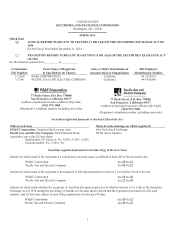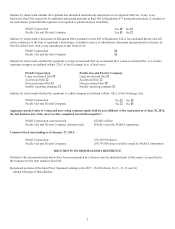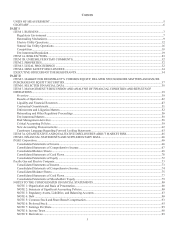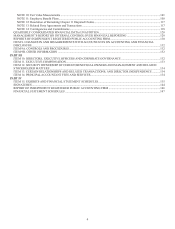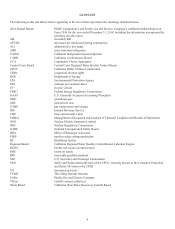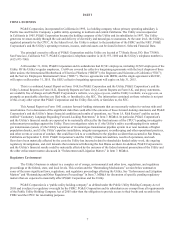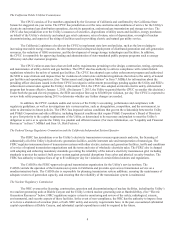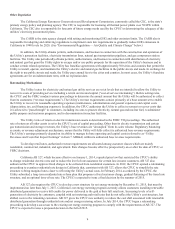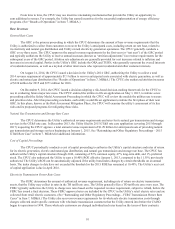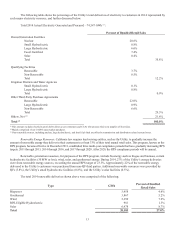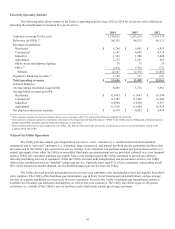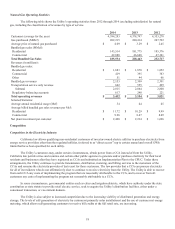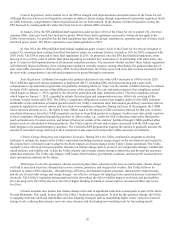PG&E 2014 Annual Report Download - page 18
Download and view the complete annual report
Please find page 18 of the 2014 PG&E annual report below. You can navigate through the pages in the report by either clicking on the pages listed below, or by using the keyword search tool below to find specific information within the annual report.10
From time to time, the CPUC may use incentive ratemaking mechanisms that provide the Utility an opportunity to
earn additional revenues. For example, the Utility has earned incentives for the successful implementation of energy efficiency
programs. (See “Results of Operations” in Item 7. MD&A.)
Base Revenues
General Rate Cases
The GRC is the primary proceeding in which the CPUC determines the amount of base revenue requirements that the
Utility is authorized to collect from customers to recover the Utility’s anticipated costs, including return on rate base, related to
its electricity and natural gas distribution and Utility owned electricity generation operations. The CPUC generally conducts a
GRC every three years. The CPUC approves the annual revenue requirements for the first year (or “test year”) of the GRC period
and typically authorizes the Utility to receive annual increases (known as “attrition adjustments”) in revenue requirements for the
subsequent years of the GRC period. Attrition rate adjustments are generally provided for cost increases related to inflation and
increases in invested capital. Parties in the Utility’s GRC include the ORA and TURN, who generally represent the overall interests
of residential customers, as well as a myriad of other intervenors who represent residential and other customer interests.
On August 14, 2014, the CPUC issued a decision in the Utility’s 2014 GRC, authorizing the Utility to collect a total
2014 revenue requirement of approximately $7.1 billion to recover anticipated costs associated with electric generation, as well as
electric and natural gas distribution (See “Results of Operations” in Item 7. MD&A.) The CPUC also authorized attrition increases
of $324 million for 2015 and $371 million for 2016.
On December 9, 2014, the CPUC issued a decision adopting a risk-based decision-making framework for the CPUC to
use in evaluating future major rate cases. The CPUC ordered the utilities to file an application on May 1, 2015, to initiate a new
proceeding called the Safety Model Assessment Proceeding in which the CPUC will review the models the utilities use to assess
and prioritize risks. After this proceeding concludes, each utility would file an application to initiate the first phase of their next
GRC. In this phase, known as the Risk Assessment Mitigation Phase, the CPUC will examine the utility’s assessment of its key
risks and its proposed programs for mitigating those risks.
Natural Gas Transmission and Storage Rate Cases
The CPUC determines the Utility’s authorized revenue requirements and rates for its natural gas transmission and storage
services in the GT&S rate case. In December 2013, the Utility filed its 2015 GT&S rate case application (covering 2015 through
2017) requesting the CPUC approve a total annual revenue requirement of $1.29 billion for anticipated costs of providing natural
gas transmission and storage services beginning on January 1, 2015. See “Ratemaking and Other Regulatory Proceedings – 2015
GT&S Rate Case” in Item 7. MD&A for additional information.
Cost of Capital Proceedings
The CPUC periodically conducts a cost of capital proceeding to authorize the Utility’s capital structure and rates of return
for its electric generation, electric and natural gas distribution, and natural gas transmission and storage rate base. The CPUC has
authorized the Utility’s capital structure through 2016, consisting of 52% common equity, 47% long-term debt, and 1% preferred
stock. The CPUC also authorized the Utility to earn a 10.40% ROE effective January 1, 2013, compared to the 11.35% previously
authorized. The Utility’s ROE can be automatically adjusted if the utility bond index changes by certain thresholds on an annual
basis. The index changes to date have not exceeded the threshold so the 2015 ROE has remained at 10.40%. The Utility’s next cost
of capital application is due in April 2016.
Electricity Transmission Owner Rate Cases
The FERC determines the amount of authorized revenue requirement, including rate of return on electric transmission
assets, that the Utility may collect in rates in the TO tariff rate case. The Utility generally files a TO tariff rate case every year. The
FERC typically authorizes the Utility to charge new rates based on the requested revenue requirement, subject to refund, before the
FERC has issued a final decision. These FERC-approved rates are included by the CPUC in the Utility’s retail electric rates and are
collected from retail electric customers. (See “Ratemaking and Other Regulatory Proceedings – FERC Transmission Owner Rate
Cases” in Item 7. MD&A.) The Utility also recovers revenue requirements for its wholesale electric transmission costs through
charges collected under specific contracts with wholesale transmission customers that the Utility entered into before the CAISO
began its operations in 1998. These wholesale customers are charged individualized rates based on the terms of their contracts.



